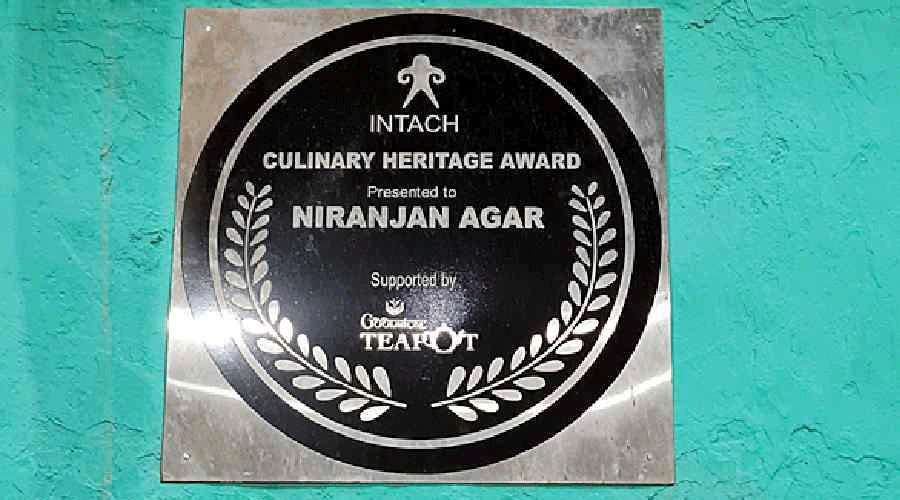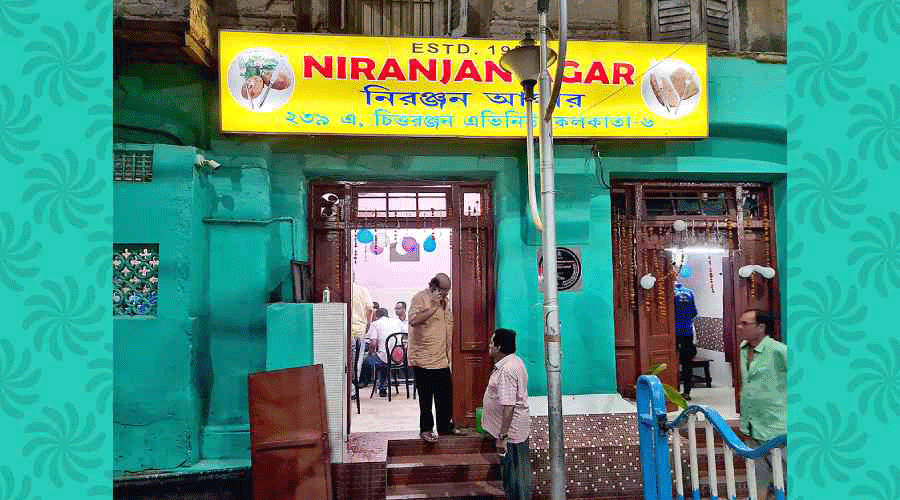Amader somoye ei jaygatar naam chilo Niranjan Bhagar (In our time, this place used to be called Niranjan Bhagar),” said Subir Dey with a twinkle in his eyes.
Dey, of course, was being wickedly funny. Bhagar — carrion depot in colloquial Bangla — after all, is hardly a fitting honorific for Niranjan Agar, a café tucked next to Nanda Mullick Lane near the Girish Park metro station. It has just turned a hundred years old. But Dey, 66 years old and an old patron of the eatery, was using the unconventional metaphor to make a point.
When he was younger, apparently most of the neighbourhood’s callow youth could be found lying prostrate — as still as corpses — inside the café, having wolfed down enormous quantities of such lip-smacking delicacies as mutton chop, deem-er devil and chicken cutlet.
Hence Agar was transformed, with dollops of para affection, into bhagar. Dey’s evenings are still incomplete without a bite of the cutlet or the fish fry. “And I remain a healthy man,” he said, before walking briskly into the gathering dusk with two steaming packets of, presumably, his beloved fix of fries. The centennial café began as a labour of love too.
Bibekananda Pan, a reticent young man and fourth-generation-owner, recounted, as he barked orders and scooped up change to be returned to customers, that Niranjan, his ancestor, had started it all in 1922 with the idea of filling stomachs between the hours of lunch and dinner with snacks and tea.“The café’s enduring popularity can be attributed to our efforts to maintain quality at a reasonable price.” Pan’s words should not be taken lightly. Aged, middle-aged and young men and women ambling through the serpentine lanes of north Calcutta after stuffing themselves with the cabin’s offerings is a common sight to this day. Niranjan Agar has always been a great leveller, accommodating in its cubby-hole interior, luminaries as well as the aam aadmi. “Uttam Kumar was a regular. His brother Tarun Kumar, Manna Dey, Utpal Dutt too,” Bibekananda reminisced, “have visited the premises.”

Intach’s culinary heritage tag. Photograph by Uddalak Mukherjee
The cafe has also bridged great distances. North Calcuttans, naturally, flock to its doors in great numbers. But southerners can be spotted too. Partha Chakraborty, almost 50 years old, has been making the journey — correction, pilgrimage — from Kasba, his abode, to Girish Park for eight years. He had discovered Niranjan Agar accidentally: he had come for some work in the neighbourhood and the growling noises from his empty stomach led him to the café. Since then, he has returned frequently. “The taste of some dishes may no longer be the same,” he said.
“But you won’t find me anywhere else.” Chakraborty has an interesting theory about the roots of his fidelity.
“I live in south Calcutta but I am a north Calcuttan at heart. The history of large parts of the southern part is indisputably linked to the rehabilitation of refugees. The displaced, unfortunately, are a rootless constituency. Their trauma prevents them from striking roots. Hence, you would not find too many institutions — cafes or eateries — surviving for long because the south loves experimentation, not tradition. But in the north, such bonds, between cafes and neighbourhoods, although fraying, have survived. This collective desire for continuity, for longevity, perhaps explains Niranjan Agar’s long life.”
And what of the future? Given the competition from new-age eateries and the rising dominance of pizza, pasta, noodles and rolls over, say, the mutton chop, does Niranjan Agar fancy scoring a double hundred in terms of longevity? On being asked this question, another elderly fan turned — the corners of his mouth were dripping chicken stew — and then turned away, towards the steaming bowl: his, clearly, was a communion immune to pesky, irrelevant queries.
Bibekananda was more forthcoming — for once. “It is true that inter-generational businesses are confronted with different challenges. The younger generation is often unwilling to enter the business. We will see how things stand. At the moment, I am more interested in maintaining the legacy and the standard of this eatery while catering to demands of newage customers. Some patrons, for example, want to savour our delicacies in air-conditioned comfort. I am looking into such demands.”
Such structural transformations, if they are to take place, may require a delicate operation. After all, Niranjan Agar was accorded a heritage tag by Intach in 2019. But that is not all. Many clients insist that they return, and will continue to return, if the ambience — a tiny space bubbling, much like its famed chicken stew, with the amor between food and food-lovers — remains unchanged. Chakraborty, the southern northerner, seemed far more optimistic. “It is a wily old place. It walks the fine line between tradition and modernity. It already has a dedicated local clientele. It may widen its arc of influence with the help of food aggregator services like Swiggy and Zomato and…”
He could not finish that sentence. For at that very moment, one of the employees came up to him bearing a plateful of liver curry. Food — especially the kind the centurion Niranjan Agar serves — can disrupt both thought and conversation.










